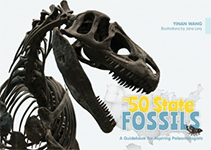 Here’s a kid’s book to consider for the holiday season: The 50 State Fossils: A Guidebook for Aspiring Paleontologists, written by Yinan Wang and illustrated by Jane Levy. It has a simple structure: each state gets a page, and that page is divided into four parts: a map of the state w/ areas highlighted showing where the fossil can be found, an illustration of the organism as it looked when it was alive, in a cartoony sort of style, a representative photograph of the fossil, and a few paragraphs of text describing the organism, its geological setting, and superlative aspects of its discovery or lifestyle. Not every state has a state fossil, but Wang rolls with the punches, presenting “state dinosaurs” where they occur, and the (fossil-derived) “state stone” in one case. For states where there are “none of the above,” Wang makes suggestions as to what would be an appropriate choice, considering the geology of the state, as well as proposed bills to designate state fossils that never made it out of their respective legislatures. This is a useful compilation of information about the range of organisms which are embraced / celebrated as state fossils. Duplicates become very apparent when reading through the whole book (as my son and I did on Monday): a lot of mammoths, a lot of trilobites, a lot of crinoids, and a lot of dinosaurs. The unique choices really stand out: belemnites (Delaware), the Tully monster (Illinois), petrified palm wood (Louisiana), and Jefferson’s ground sloth (West Virginia). My own state, Virginia, has the elegant Pliocene scallop Chesapecten jeffersonius as its state fossil for many good reasons. I have a couple of personal connections to the story of that bill, and am pleased that its story is included in the brief description. In 1687, it was the very first fossil from the Americas to be illustrated in the scientific literature. So illustrating it is key to its selection, and it pains me to say that the photo used to illustrate the fossil appears to be another species in the Chesapecten genus, perhaps C. middlesexensis or C. madisonius. You can count the ribs – C. jeffersonius should only have 8 or 9 ribs, but the individual shown in the photo has 12 ribs. I found one small typo too. These are relatively minor details, and for the intended audience of paleophile children, I don’t think they matter in any essential way. I think the book would make an admirable addition to the bookshelves of young paleontologists. My son (6 years old) really enjoyed it, and has gone back to it several times since to leaf through and re-examine the critters. He’s particularly taken with Shonisaurus, the Nevadan icthyosaur!
Here’s a kid’s book to consider for the holiday season: The 50 State Fossils: A Guidebook for Aspiring Paleontologists, written by Yinan Wang and illustrated by Jane Levy. It has a simple structure: each state gets a page, and that page is divided into four parts: a map of the state w/ areas highlighted showing where the fossil can be found, an illustration of the organism as it looked when it was alive, in a cartoony sort of style, a representative photograph of the fossil, and a few paragraphs of text describing the organism, its geological setting, and superlative aspects of its discovery or lifestyle. Not every state has a state fossil, but Wang rolls with the punches, presenting “state dinosaurs” where they occur, and the (fossil-derived) “state stone” in one case. For states where there are “none of the above,” Wang makes suggestions as to what would be an appropriate choice, considering the geology of the state, as well as proposed bills to designate state fossils that never made it out of their respective legislatures. This is a useful compilation of information about the range of organisms which are embraced / celebrated as state fossils. Duplicates become very apparent when reading through the whole book (as my son and I did on Monday): a lot of mammoths, a lot of trilobites, a lot of crinoids, and a lot of dinosaurs. The unique choices really stand out: belemnites (Delaware), the Tully monster (Illinois), petrified palm wood (Louisiana), and Jefferson’s ground sloth (West Virginia). My own state, Virginia, has the elegant Pliocene scallop Chesapecten jeffersonius as its state fossil for many good reasons. I have a couple of personal connections to the story of that bill, and am pleased that its story is included in the brief description. In 1687, it was the very first fossil from the Americas to be illustrated in the scientific literature. So illustrating it is key to its selection, and it pains me to say that the photo used to illustrate the fossil appears to be another species in the Chesapecten genus, perhaps C. middlesexensis or C. madisonius. You can count the ribs – C. jeffersonius should only have 8 or 9 ribs, but the individual shown in the photo has 12 ribs. I found one small typo too. These are relatively minor details, and for the intended audience of paleophile children, I don’t think they matter in any essential way. I think the book would make an admirable addition to the bookshelves of young paleontologists. My son (6 years old) really enjoyed it, and has gone back to it several times since to leaf through and re-examine the critters. He’s particularly taken with Shonisaurus, the Nevadan icthyosaur!

Not sure “paleophile” should be a word 🙂
Maybe not… but “paleontologicophile” smacks of “uniformitarianism” when the much more elegant “principle of uniformity” would do. What do you suggest instead?
I almost always order the books you review positively. Many of your suggestions land on my top 10 list of the year. I’m 70 years old so I think I will love this book on 50 state fossils. I might be the one in Pennsylvania. I ordered it! Thank you for your posts.